
 i_need_contribute
i_need_contribute
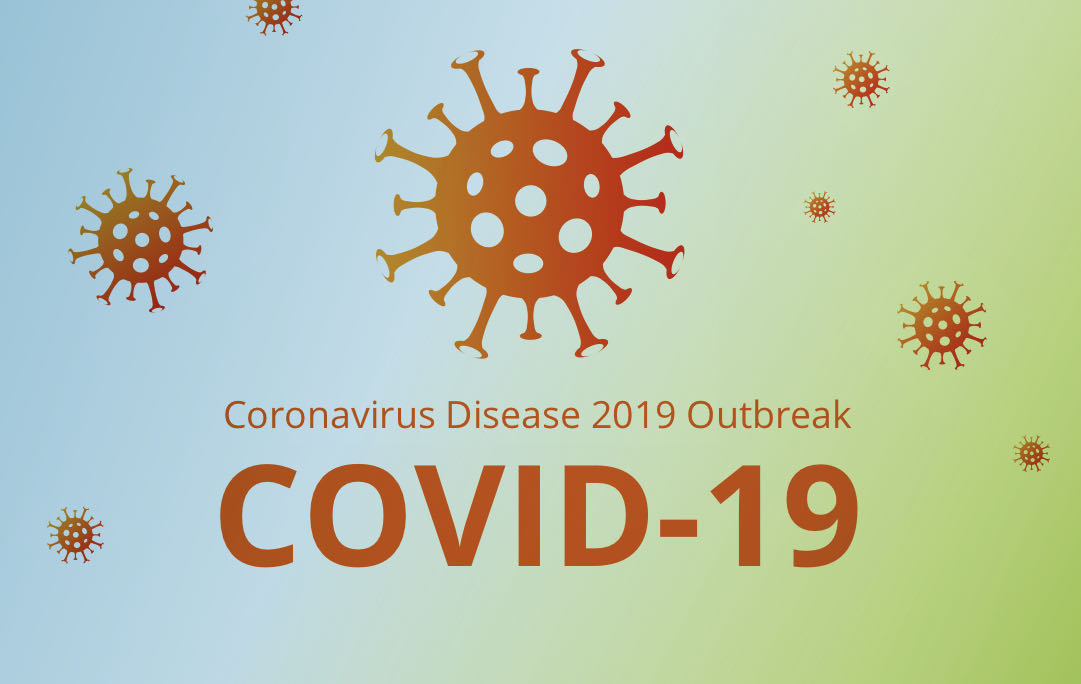
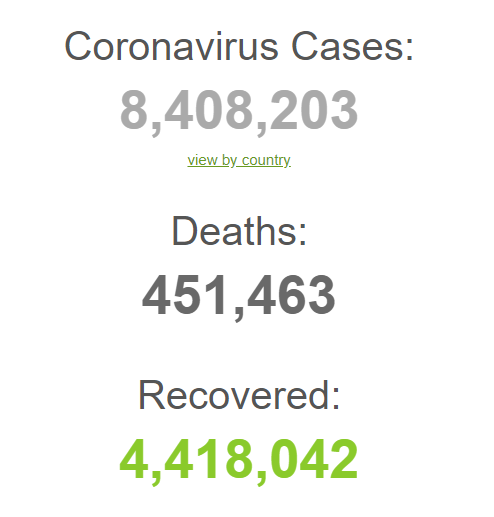
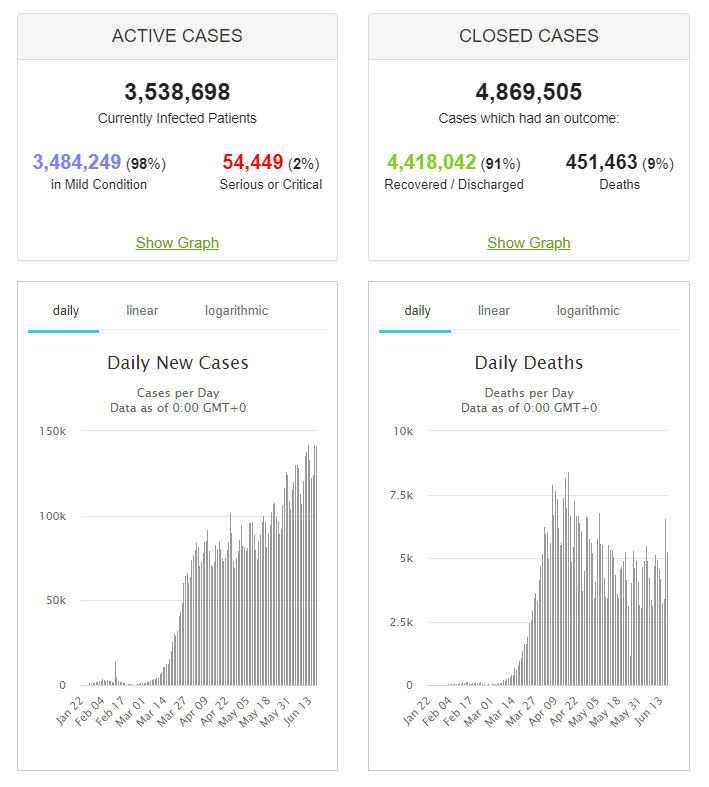
|
# |
Country, |
Total |
New |
Total |
|
|
World |
8,393,096 |
+141,872 |
450,452 |
|
1 |
2,234,471 |
+26,071 |
119,941 |
|
|
2 |
960,309 |
+31,475 |
46,665 |
|
|
3 |
553,301 |
+7,843 |
7,478 |
|
|
4 |
367,264 |
+13,103 |
12,262 |
|
|
5 |
299,251 |
+1,115 |
42,153 |
|
|
6 |
291,763 |
+355 |
27,136 |
|
|
7 |
240,908 |
+3,752 |
7,257 |
|
|
8 |
237,828 |
+328 |
34,448 |
|
|
9 |
195,051 |
+2,612 |
9,185 |
|
|
10 |
190,179 |
+1,797 |
8,927 |
|
|
11 |
184,449 |
|
3,615 |
|
|
12 |
182,727 |
+1,429 |
4,861 |
|
|
13 |
158,174 |
+458 |
29,575 |
|
|
14 |
154,863 |
+4,599 |
18,310 |
|
|
15 |
154,760 |
+5,839 |
2,975 |
|
|
16 |
141,234 |
+4,919 |
1,091 |
|
|
17 |
99,853 |
+386 |
8,254 |
|
|
18 |
98,489 |
+4,008 |
1,305 |
|
|
19 |
83,265 |
+44 |
4,634 |
|
|
20 |
83,174 |
+1,097 |
82 |
|
|
21 |
80,412 |
+4,078 |
1,674 |
|
|
22 |
60,244 |
+89 |
9,675 |
|
|
23 |
57,046 |
+2,115 |
1,864 |
|
|
24 |
56,032 |
+663 |
324 |
|
|
25 |
54,562 |
+1,239 |
5,041 |
|
|
26 |
49,219 |
+1,363 |
1,850 |
|
|
27 |
49,204 |
+117 |
6,074 |
|
|
28 |
48,490 |
+547 |
4,007 |
|
|
29 |
43,364 |
+382 |
295 |
|
|
30 |
41,431 |
+1,031 |
2,276 |
|
|
31 |
41,216 |
+247 |
26 |
|
|
32 |
37,672 |
+336 |
1,523 |
|
|
33 |
37,533 |
+575 |
306 |
|
|
34 |
35,552 |
+1,393 |
913 |
|
|
35 |
33,234 |
+758 |
943 |
|
|
36 |
31,187 |
+33 |
1,956 |
|
|
37 |
30,701 |
+506 |
1,286 |
|
|
38 |
27,238 |
+457 |
1,108 |
|
|
39 |
26,874 |
+564 |
504 |
|
|
40 |
26,079 |
+810 |
116 |
|
|
41 |
25,341 |
+7 |
1,710 |
|
|
42 |
24,254 |
+1,554 |
773 |
|
|
43 |
24,105 |
+419 |
633 |
|
|
44 |
22,760 |
+345 |
1,451 |
|
|
45 |
22,597 |
+635 |
470 |
|
|
46 |
19,961 |
+408 |
49 |
|
|
47 |
19,883 |
+810 |
659 |
|
|
48 |
19,783 |
+288 |
303 |
|
|
49 |
18,033 |
+544 |
302 |
|
|
50 |
17,735 |
+587 |
469 |
|
|
51 |
17,628 |
+41 |
931 |
|
|
52 |
17,203 |
+14 |
687 |
|
|
53 |
15,542 |
+350 |
97 |
|
|
54 |
12,732 |
+478 |
433 |
|
|
55 |
12,590 |
+397 |
66 |
|
|
56 |
12,522 |
+96 |
257 |
|
|
57 |
12,294 |
+44 |
598 |
|
|
58 |
12,198 |
+43 |
279 |
|
|
59 |
11,268 |
+121 |
799 |
|
|
60 |
10,991 |
+329 |
133 |
Source:https://www.worldometers.info/coronavirus/
Vice President Mike Pence argued in a Wall Street Journal opinion piece that concern over a “second wave” of the coronavirus was “overblown” and that “we are winning the fight against the invisible enemy.” Dr. Anthony S. Fauci, the government’s top epidemiologist, also said that the country was not in a “second wave,” but for a very different reason: He warned that the nation was still in the first wave.
“People keep talking about a second wave,” Mr. Fauci said in an interview with The Wall Street Journal on Tuesday. That is not accurate, he said, because “we’re still in a first wave.”
Mr. Pence’s argument appears to have oversimplified a complicated picture, emphasizing regions where the pandemic is waning while explaining away surging infection rates in other states. His rosy picture conformed with President Trump’s desire to reopen the economy and get Americans back to work, but it ignored bad news, especially in the Sun Belt.
In at least 20 states, new cases are increasing, some at alarming rates. Some states, including Texas, South Carolina and Arizona, are seeing their largest surges yet, according to data compiled by The New York Times.
In his op-ed, Mr. Pence said that expanded testing revealed that fewer than 6 percent of Americans tested every week have the virus. On a call with governors Monday, Mr. Pence encouraged them to adopt the administration’s explanation that a rise in testing was behind new outbreaks, a claim that Dr. Fauci rebutted on Tuesday, when he said that the higher percentages of positive tests “cannot be explained by increased testing.”
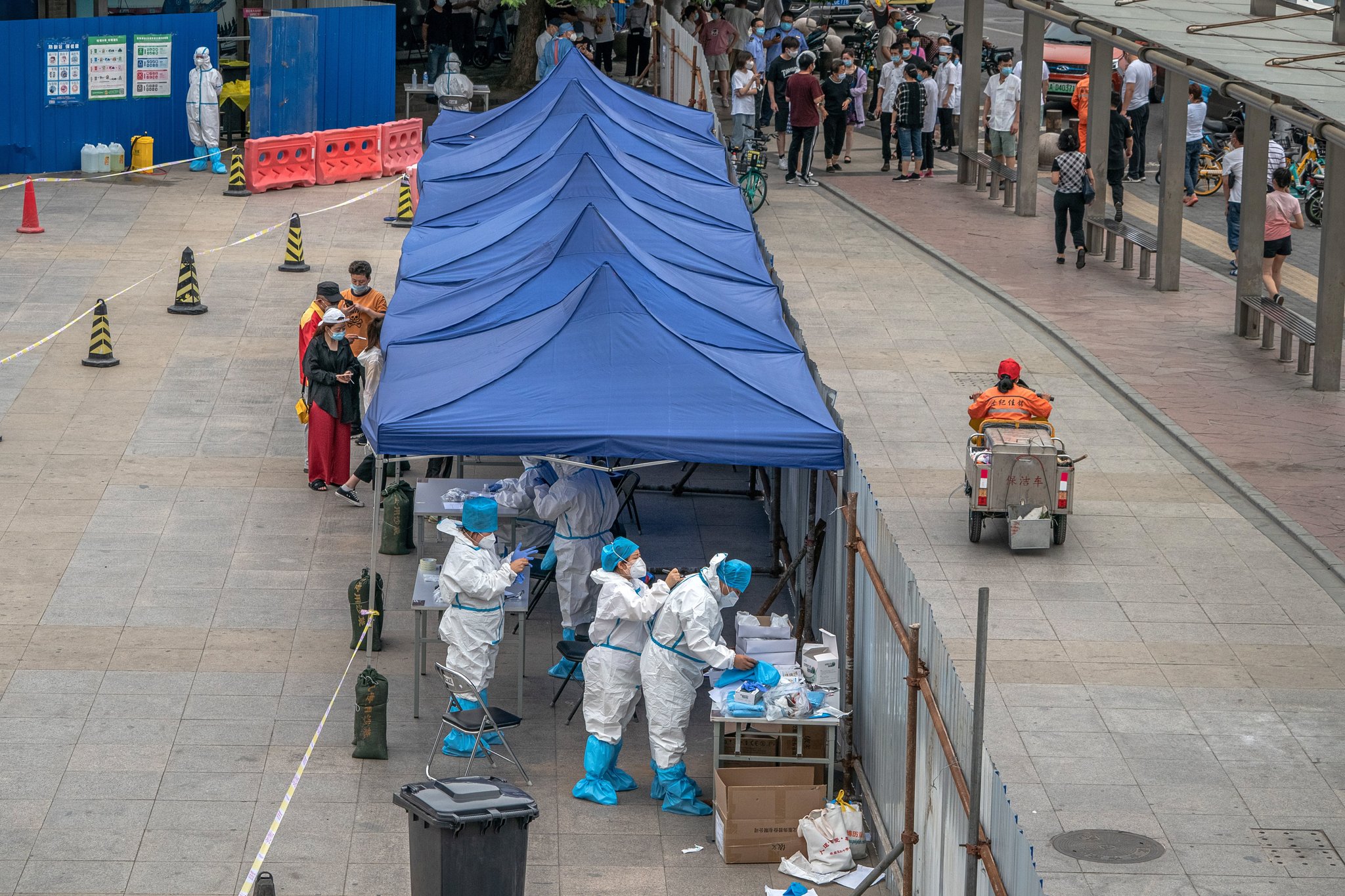
A makeshift coronavirus testing center in Beijing on Wednesday.Credit...Roman Pilipey/EPA, via Shutterstock
Zhong Nanshan, an 83-year-old doctor who specializes in respiratory ailments, occupies a status in China roughly similar to Anthony Fauci’s in the United States: that of a widely respected medical expert whose plain-spoken views carry particular weight.
Dr. Zhong in 2003 helped to uncover the coronavirus behind the SARS epidemic in China. This year, he pushed back against local officials reluctant to acknowledge the threat from the new coronavirus, and he warned the government and the public that the virus was spreading from human to human.
On Thursday, Dr. Zhong told an online seminar organized by the University of Sydney that China needed to give its centers for disease control more power, independence, expertise and money to ensure that they serve as independent sentinels against dangerous outbreaks. The changes should not be “prolonged” or “delayed,” he added.
China’s network of centers for disease control is supposed to identify and report on potentially dangerous infectious diseases. But in Wuhan, the central Chinese city where the new coronavirus began to spread late last year, officials slowed the collection and release of information that might have enabled the authorities to act sooner against spreading infections, evidence from doctors and official documents has shown.
“Their position should be elevated so it’s not only for research or just giving some information to the local authorities. They should, in some part, be independent,” Dr. Zhong told the seminar, speaking in English. “The C.D.C. should have the right — should be more independent — to announce what’s their view, what’s their point, in particular in the emerging infectious diseases.”
Chinese leaders, including Xi Jinping, head of the ruling Communist Party, have said that the country’s public health system needs to improve in the wake of the pandemic, but they have not given details. And medical experts like Dr. Zhong appear to be pressing the government to act with greater urgency on their proposals.
The Beijing city government on Thursday reported 21 more cases of patients who tested positive for the virus and showed symptoms, bringing the total number of new symptomatic cases from a recent local outbreak to 158.
Dr. Zhong said that it would be two or three days before it became clear whether the renewed surveillance and controls in the capital had succeeded.
“That’s a big challenge to Beijing,” he said. “We don’t know whether this action will be effective or not.”

Manchester City played Arsenal at Etihad Stadium in Manchester, England, on Wednesday.Credit...Pool photo by Laurence Griffiths
When Premier League soccer returned to England on Wednesday after a 100-day shutdown, players knelt in support of the Black Lives Matter movement and observed a minute of silence in memory of coronavirus victims.
Two games were played, in Manchester and Birmingham, and a full slate of matches is scheduled for the weekend. For the rest of the season, Premier League jerseys will feature a Black Lives Matter logo and a badge thanking Britain’s overburdened National Health Service — a show of appreciation for medics who have treated coronavirus patients.
Also on Wednesday, the Champions League took its first concrete steps toward returning. Officials from European soccer’s governing body, UEFA, announced that the competition — suspended three months ago — would be completed as an eight-team knockout tournament in August in Portugal.
During the 100 days without the Premier League, England did not seem to stop talking about it, our soccer columnist Rory Smith writes. For example: Were players doing enough to help the N.H.S.? And should clubs be allowed to use the government’s furlough scheme?
“Most of all, though,” Rory writes, “as the death tolls mounted and the lockdown gripped, it asked again and again if soccer could return in the world of the coronavirus, or, more pertinent, whether it should. And then it asked, again and again, why everyone was talking about soccer so much.”
Australia’s locked-down international borders could see their first major opening next month, as two universities make plans to fly in a select group of international students who have nearly completed their degrees.
The proposal from the Australian National University and the University of Canberra is one of several plans being presented to Australia’s federal government by universities and states seeking travel exemptions that aim to be a model for others.
Under the latest plan, the universities would ask around 350 students to fly to a hub destination, such as Singapore, where they would connect to a charter flight hired by the universities. Both are based in Canberra, Australia’s capital city.
Upon arrival, the students would be quarantined in a hotel for 14 days and tested for Covid-19 at the beginning and end of their stay. The government of the capital territory, which has approved the plan, would take responsibility for managing the quarantine period and clearing the students for a return to campus.
Students with clear practical requirements or research projects that need to be finished would be given priority at first, but university officials said the goal was to create a process that could be broadened over time.
“We need a trial for Australia to build that confidence,” Paddy Nixon, the vice chancellor at the University of Canberra, told Australia’s main public broadcaster.
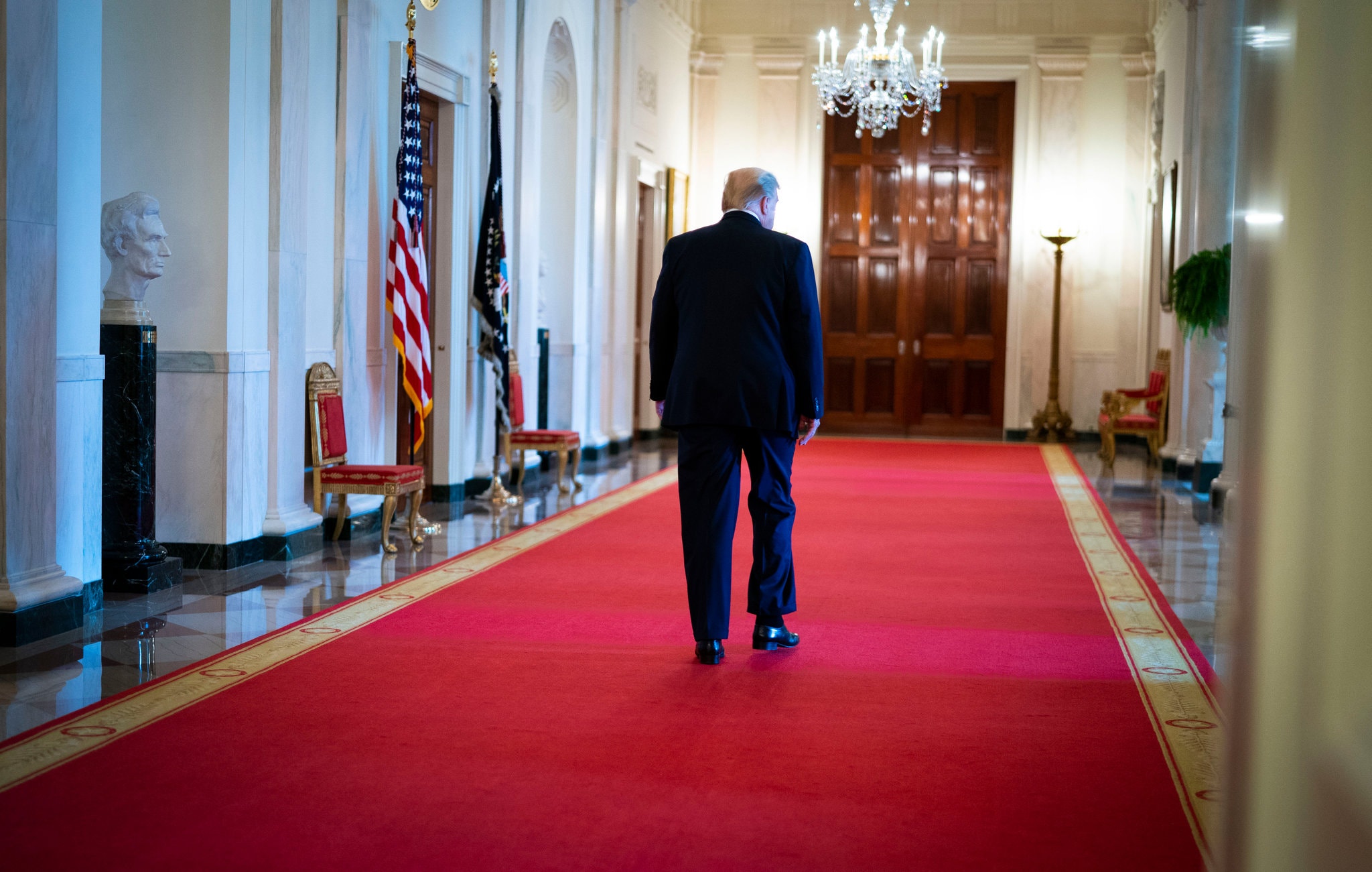
President Trump leaving the East Room of the White House after an event on Wednesday.Credit...Doug Mills/The New York Times
The federal government’s leadership in the coronavirus crisis has so faded that state and local health officials have been left to figure out on their own how to handle rising infections and to navigate conflicting signals from the White House.
About 800 Americans a day are still dying of Covid-19, a pace that, if sustained over the next few months, would yield more than 200,000 dead by the end of September. Arizona, Florida, Nevada, Oregon and Texas all reported their largest one-day increases in new cases on Tuesday.
On Wednesday, Oklahoma recorded 259 new cases, a single-day record for the second day in a row, and just three days before President Trump is scheduled to hold an indoor campaign rally in Tulsa in defiance of his own administration’s guidelines for “phased reopening.”
That rally is not the only confusing signal from Washington. The Trump campaign is requiring rally-goers to sign a statement waiving their right to sue the campaign if they get sick.
While the president refuses to wear a mask, Surgeon General Jerome M. Adams has spent this week doing a round of television interviews to implore Americans to do so. Meantime, Vice President Mike Pence insisted in an opinion piece in The Wall Street Journal this week that panic over a second wave was “overblown.”
To public health experts, it is little mystery why Americans are confused. As the White House sends mixed messages, Washington’s public health bully pulpit has largely fallen silent.

Health workers transported a virus patient in Port-au-Prince, Haiti on Monday.Credit...Jean Marc Herve Abelar/EPA, via Shutterstock
As the coronavirus spreads across Latin America and the Caribbean, public health officials are flagging outbreaks cropping up in several border regions, particularly the one between Haiti and the Dominican Republic.
The Pan American Health Organization said this week that it was focusing its efforts in these rural frontier areas, where populations are on the move and medical facilities are lacking. Indigenous people and migrants, vulnerable under normal circumstances, face even greater risks now.
Many Haitians live and work in the Dominican Republic, but after the outbreak there, thousands lost their jobs and moved back to Haiti. Some may have brought the virus with them.
According to the International Organization of Migration, there were more than 278,000 border crossings from March 17 to June 7, with a total of 51,000 going to Haiti, an unusually high number, according to Giuseppe Loprete, the organization’s chief of mission in Haiti. He added that the weekly average of 4,000 crossings was about double the normal figure.
For many migrants, the stigma associated with the disease has made some of those safeguards, like contact tracing, even more difficult. Mr. Loprete said that many people returning to Haiti leave inaccurate contact numbers because they do not want community members to treat them as sick.
In addition to Haiti and the Dominican Republic, Dr. Carissa F. Etienne, the director of the P.A.H.O., cited spikes in other border areas, including the one between Costa Rica and Nicaragua and the Amazon region that Brazil shares with its neighbors.
From journalist Anna Kam
Australian Prime Minister Scott Morrison said the country is facing “dark times” as he announced unemployment figures in a news conference today.
Morrison said 838,000 Australians have lost jobs and experienced “hard days” in the past three months during the coronavirus pandemic.
Earlier, the Australian Bureau of Statistics (ABS) released unemployment figures of 227,700 in May alone. Women and younger workers have been particularly impacted during this period, it said.
Morrison estimates that it will take Australia “around two years to get the economy back to where it was before Covid hit,” and said “coronavirus is the reason people have lost their jobs.”
Last Friday, the Australian government announced further easing of social distancing rules set to take place in July. Morrison said the “priority is to get Australians back to work.”
Australia has confirmed a total of 7,370 cases of the virus, including 102 deaths, according to the Department of Health. Some 6,870 people have recovered.
“These are our dark times, but I can see that ray of light, and I'm sure Australians can too, but we have got to keep moving towards it. We've got to keep working harder each and every day,” Morrison said.
New Zealand has reported one new Covid-19 case, a man in his 60s who flew to the country from Lahore, Pakistan, the health ministry said.
The man is in a quarantine facility in Auckland.
He flew from Lahore to Doha, and then from Doha to Melbourne, Australia on June 11. He then flew from Melbourne to Auckland on June 13.
New Zealand's health ministry said it is following up on any potential contacts, including every passenger on the Air New Zealand flight to Auckland.
The man did not show any symptoms when he checked into a managed isolation facility on his arrival. Two days later he developed symptoms and was transferred to a quarantine facility.
He tested positive for coronavirus on June 16.
The total number of confirmed cases in New Zealand is now 1,157, according to the health ministry.
On Tuesday, New Zealand reported its first coronavirus cases in more than three weeks after two women who traveled to the country from the UK were found to have Covid-19.
From CNN Health’s Jen Christensen
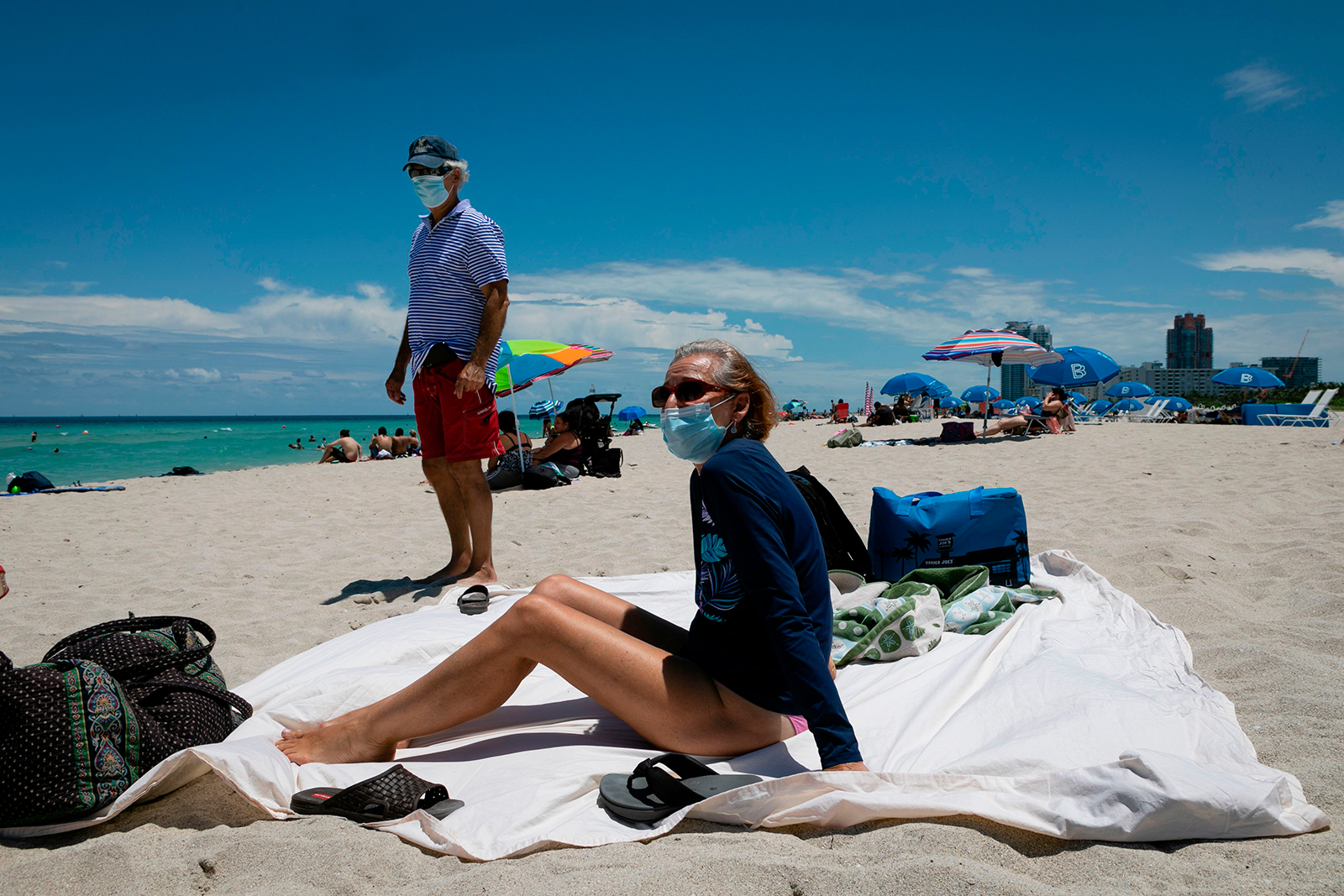
A woman sunbathes at the beach next to her husband, both wearing face masks, in Miami Beach, Florida on June 16. Eva Marie Uzcategui/AFP/Getty Images
Florida has “all the markings of the next large epicenter" of coronavirus transmission, with the risk being the “worst it has ever been” according to new projections.
The other areas of concern for additional widespread community transmission include the Carolinas, Texas, and Arizona.
The model was put together by a team of scientists at the Children’s Hospital of Philadelphia and the University of Pennsylvania.
The version of this model used local data from 517 counties with active outbreaks to provide short-term forecasts of where Covid-19 cases would be.
Florida’s Republican Gov. Ron DeSantis has attributed the recent spike in cases in his state to aggressive testing and blames outbreaks in prisons, agricultural communities and long-term care facilities.
Experts said the numbers of new infections are definitely increasing and it’s not just because there’s more testing.
Miami and some of Florida’s southeastern counties, along with the Tampa and Fort Myers area and Orlando can expect to see a widespread transmission event and case numbers will likely then rise in the rest of the state, according to the model.
It also predicts problem spots for vacation areas like Galveston, Texas and Lake Charles, Louisiana.
Bright spots: Despite reopening early, one bright spot in the model includes Atlanta and much of Georgia, which seem to have kept cases in check. The Midwest and Northeast, which have remained in lockdown longer than other areas of the country, also are predicted to see a decline in case counts through July.
From CNN's Natalie Gallón in Mexico City and Stefano Pozzebon in Bogota, Colombia
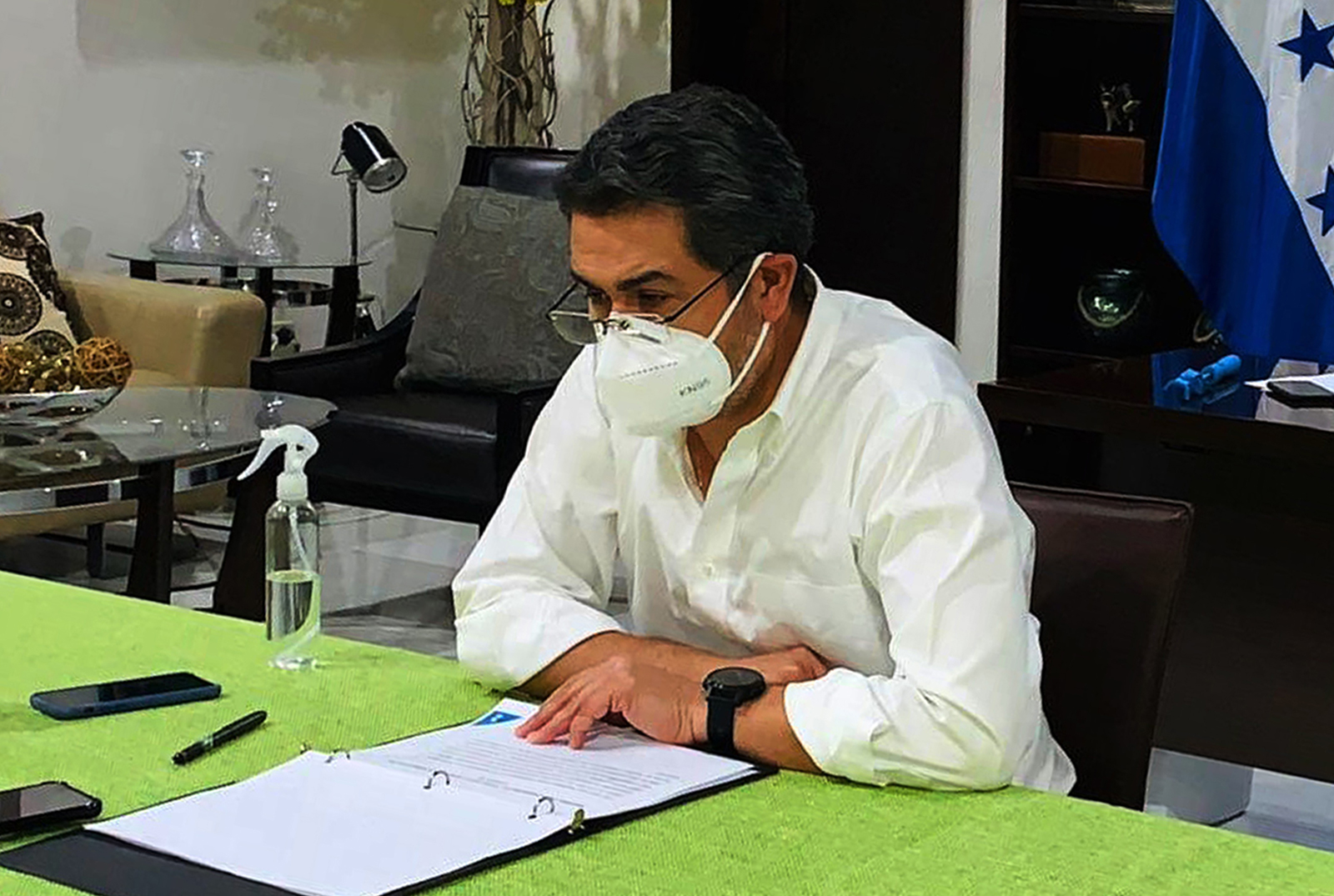
Honduran President Juan Orlando Hernandez wears a face mask in Tegucigalpa, Honduras on June 15. Orlando Sierra/AFP/Getty Images
Honduran President Juan Orlando Hernández is being treated for pneumonia after having "slight leaks in the lungs."
The President is "stable, in good spirits and receiving medication," according to Francis Contreras, a spokesman for the Honduran Health Regulation Agency.
President Hernández said Wednesday he and his wife had tested positive for Covid-19.
Honduran First Lady, Ana García de Hernández, is stable and without symptoms, according to Chancellor and Commissioner for the pandemic, Lisandro Rosales.
Hernández is the first president in the world to announce he has tested positive for the virus.
From CNN's Christopher Ulloa in Santiago, Chile and Matt Rivers and Natalie Gallón in Mexico City
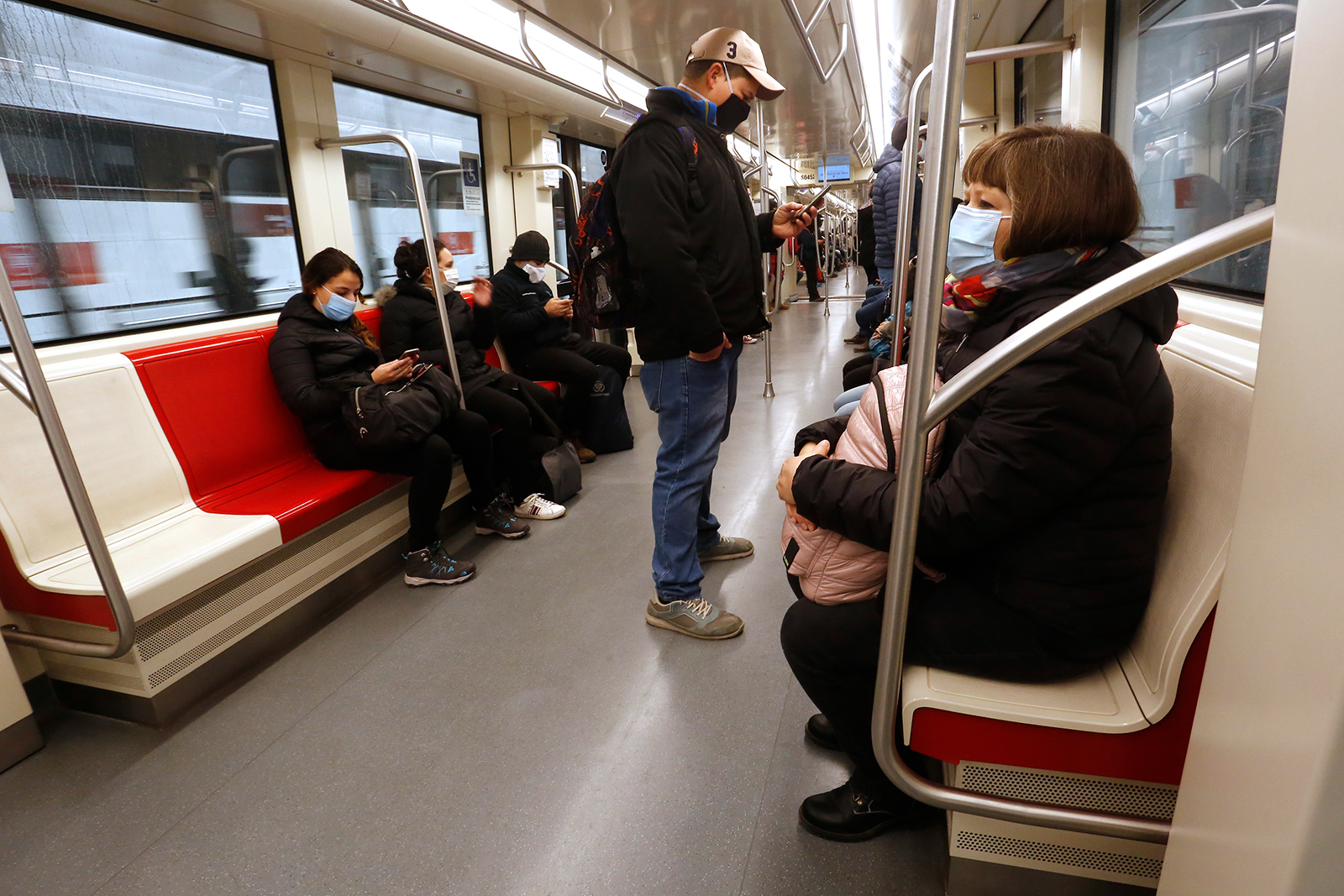
People wearing face masks ride the subway on June 16, in Santiago, Chile. Marcelo Hernandez/Getty Images
Chile’s health ministry reported an additional 31,000 Covid-19 cases Wednesday that had not previously been counted after the government discovered a backlog of positive test results dating back to March.
The ministry also reported 4,757 newly confirmed cases Wednesday, bringing the country’s total to 220,628.
Authorities have tightened lockdown measures in the greater Santiago area, the country’s capital with more than 6 million residents.
Residents will only be allowed out of their homes twice a week now, down from the previous five, and only under strict conditions.
People found violating quarantine measures can now face up to five years in prison for doing so.
Chile also reported an additional 232 deaths on Wednesday, raising the country’s total to 3,615.
Source:https://edition.cnn.com/world/live-news/coronavirus-pandemic-06-18-20-intl/index.html
Here are the key developments from the last few hours:
· The global death toll from coronavirus is nearing 450,000, with more than 8.2 million confirmed cases of the disease worldwide. The Johns Hopkins University tracker is recording more than 448,959 deaths from Covid-19 across the world, as of Wednesday evening UK time. More than one in four fatalities are in the US, making it by far the worst-hit country. There are 8,349,950 cases worldwide.
· Brazil cases near 1 million. Brazil recorded 1,269 additional Covid-19 deaths on Wednesday, bringing its official death toll from the novel coronavirus to 46,510, the most in the world outside the United States. The Health Ministry also registered 32,188 new cases of the virus since its Tuesday update, for a total of 955,377 confirmed cases, also second to the United States globally.
· India sees highest one-day case spike. India has reported its highest cases in the pandemic so far, with 12,881 confirmed in the last 24 hours, for a total of 366,946 cases. There have been 334 additional deaths, bringing the toll to 12,237.
· UK cases pass 300,000. The number of coronavirus infections in the UK has passed 300,00, according to the Johns Hopkins University tracker, with the current total standing at 300,717.At least 42,238 people have died in the UK so far.
· WHO hails steroid treatment ‘hope’. The cheap steroid British researchers believe can help save lives should be used only for the most serious cases, the World Health Organization (WHO) has said.The WHO chief Dr Tedros Adhanom Ghebreyesus said research was at last providing “green shoots of hope”.
· Arizona governor to let mayors require masks as Covid-19 cases surge. As coronavirus cases surge across the state, Arizona’s Republican governor said he would no longer block mayors from being able to require local residents to wear masks.But governor Doug Ducey held off from issuing a statewide mask-wearing requirement, even after hundreds of Arizona medical professionals sent him an open letter this week, outlining the evidence that masks save lives and asking him to require citizens to wear them.
· Argentina’s president Alberto Fernández has gone into voluntary isolation, amid growing concerns over a surge of coronavirus infections, including several cases among the country’s political elite.The decision to quarantine the president – whose popularity is riding high on his no-nonsense response to the pandemic – was taken due to the “significant increase in the circulation of the virus,” presidential doctor Federico Saavedra said in a statement on Wednesday.
· Honduras president hospitalized with pneumonia, Covid-19. President Juan Orlando Hernández announced late Tuesday that he and his wife had tested positive for the virus. Just hours later he was hospitalised after doctors determined he had pneumonia. From March to 7 June, Honduras confirmed 6,327 coronavirus infections. In the 10 days since, it added 3,329 more, a surge that has come after the government began a gradual reactivation of the economy.
· New Zealand confirms one new case; defences under scrutiny as more breaches emerge. More reports have emerged in New Zealand of people leaving isolation without being tested and going on to meet friends, placing government officials under increasing scrutiny over the rigour of their Covid-19 quarantine rules.Police revealed that six people absconded from managed isolation after being granted compassionate leave from Covid-19 quarantine to attend a funeral in Hamilton.
· Australia’s Qantas cancels most international flights until October. Qantas Airways said on Thursday it had cancelled most international flights until late October, after the Australian government indicated its border closure because of the coronavirus was likely to extend to 2021.
· Australian unemployment reaches 7.1%. Australia’s unemployment rate has jumped to 7.1% after another 227,700 people lost their jobs thanks to coronavirus. The jobless rate had already climbed from 5.2% in March to a revised 6.4% in April, as the deadly global pandemic gripped the country. May’s monthly drop in the number of people employed is the second largest on record after nearly 600,000 got sacked in April. Another poor set of figures had been expected as a result of nationwide lockdowns.
· Beijing records 21 new cases. Beijing confirmed 21 new Covid-19 cases as of June 17, China’s health authority said on Thursday, down from 31 a day earlier. Beijing logged its first case in the current outbreak, the worst in the city since early February, on 11 June. The total number of infections has risen to 158 over the past week.